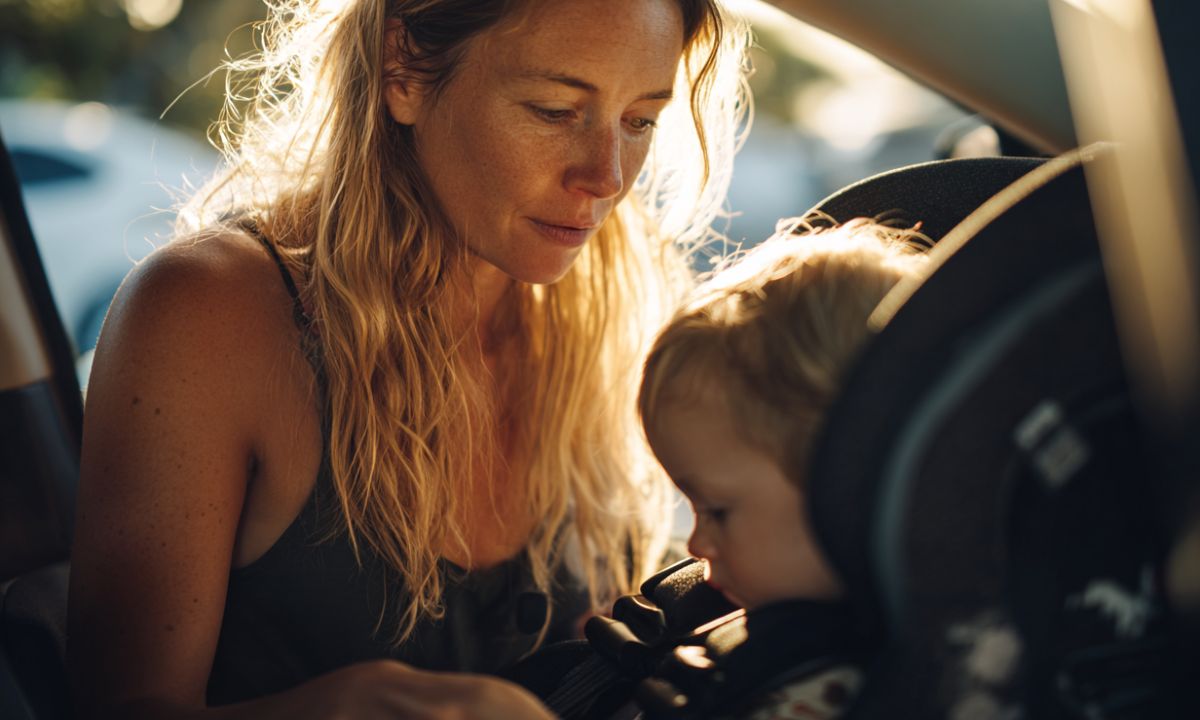Child Seat Savvy: 2025 Updates on Keeping Kids Safe on Queensland Roads

Imagine you're loading the family car for that long-awaited holiday to the Gold Coast. The playlist is ready and everyone's buzzing with excitement. But as you buckle in your child, a nagging question crosses your mind: Is this seat really protecting them the way it should?
In Queensland, up to 90% of child car seats are incorrectly installed or used. Many parents who think they're doing everything right are unknowingly putting their children at risk every single journey.
Queensland's 2025 Child Restraint Laws: What's Changed?
Current Queensland legislation requires specific restraint types based on age groups, and getting it wrong can cost you more than just money.
Here's what you need to know for each age group:
Birth to 6 months: Your little one must travel in an approved rear-facing restraint only. The rear-facing position protects their developing neck and spine in ways that forward-facing seats simply can't match.
6 months to 4 years: You can choose between rear-facing or forward-facing seats with built-in harness systems. Many safety experts recommend keeping children rear-facing for as long as possible, often until they're well past their second birthday.
4 to 7 years: Forward-facing seats with harnesses or booster seats with properly fitted lap-sash seatbelts become options. Many children this age are moved to adult seatbelts too early.
7 years and older: Booster seats or adult seatbelts are permitted, but just because your seven-year-old legally can use an adult seatbelt doesn't mean they should.
Queensland Police now issue fines of $1,251 and four demerit points for each improperly restrained child. Repeat offenders within twelve months face double demerit points, which can quickly add up to licence suspension.
Restraints need to meet the AS/NZS 1754 Australian Standard to be legally acceptable, which can often catch some families out.
What's New: Smart Seats and Tech-Driven Safety in 2025
Some smart car seat accessories now come equipped with sensors that alert you via smartphone app if the harness isn't tight enough or if the seat isn't installed correctly. Some of the most impressive innovations (currently available overseas) include automatic harness adjustment systems that adapt as your child grows.
It's important to remember that even the smartest technology in the world can't replace fundamental knowledge about child restraint safety. These features work best when parents understand the basics and use technology as a backup, not a substitute for proper education and professional fitting checks.
Common Errors: Why Most Parents Get It Wrong

Outgrown restraints: Many parents upgrade based on age rather than their child's actual height and shoulder measurements. Your three-year-old might still be perfectly safe in their rear-facing infant seat if they haven't exceeded the shoulder height markers.
Installation issues: Loose seatbelts, twisted straps, incorrectly angled rear-facing seats and improperly secured tether straps top the list.
Harness problems: Twisted harness straps, incorrect chest clip positioning (if using an after-market chest clip accessory), and loose harnesses that allow too much movement are incredibly common. The harness should be snug enough that you can't pinch any slack at your child's shoulder.
Using expired or damaged seats: Plastic degrades over time, and seats involved in crashes can have structural damage that isn't visible. Any seat older than ten years or involved in a collision should be replaced immediately.
If you’re unsure whether you’re getting it right, Kidsafe Queensland offer free checks to anyone to ensure your child is safe.
*While aftermarket chest clips like the Houdini Stop are available for purchase online and have been crash tested to Australian standards (AS/NZS 1754), chest clips are not standard features on Australian car seats and their use remains a personal choice for parents as an optional accessory
Crash Stats: The Real Impact of Incorrect Restraints
Queensland's Family and Child Commission revealed that in the last 20 years, 123 Queensland children have sadly died in road accidents. Many of these children were either not restrained correctly or not restrained at all.
The difference between proper and improper restraint use is the difference between walking away from a crash with minor bruises versus facing life-changing injuries or worse. In crash after crash, investigators find that children properly restrained in age-appropriate, correctly installed seats fare dramatically better than their improperly restrained siblings or friends.
Best Practices for Every Age and Stage
Understanding when to transition between restraint types requires more than simply checking your child's birthday. Physical development varies enormously among children, and safety depends on how well the restraint fits your child.
You should keep children in each stage as long as possible before moving to the next. Rear-facing seats protect better than forward-facing ones. Five-point harnesses protect better than adult seatbelts. Booster seats protect better than adult seatbelts alone.
When transitioning to adult seatbelts, your child should pass all parts of the five-step test: back flat against the seat, knees bending comfortably at the seat edge, lap belt sitting low across hips (not the stomach), shoulder belt crossing the middle of the shoulder and chest (not the neck), and the ability to stay in this position for the entire journey.
Most children don't pass this test until they're at least 145cm tall, which often doesn't happen until they're ten or eleven years old. Queensland's legal minimum of seven years represents when adult seatbelts become legally permissible, not necessarily when they become safe.
What If the Worst Happens? Child Injury Claims After a Crash
No parent wants to think about their child being injured in a car accident, but understanding the legal landscape can make a devastating situation slightly more manageable. In Queensland, compensation for child injuries typically flows through the Compulsory Third Party (CTP) insurance system, with specific considerations for young passengers.
Immediately after any crash involving a child you should:
Document everything. Take photos of the car seat installation, the restraint itself, and any damage. Record the seat's make, model, manufacturing date, and installation method. Keep all receipts, instruction manuals and any professional fitting certificates.
Seek immediate medical attention, even if injuries seem minor. Some crash-related injuries in children don't become apparent for hours or days after the incident. Having complete medical records from the time of the crash can be crucial for any future claim.
How restraint use affects compensation:
Proper restraint use strengthens any compensation claim, while improper use can complicate the process. Insurance companies will investigate whether appropriate restraints were used correctly, and their findings can significantly impact settlement amounts.
Time limits apply strictly to injury claims, so seeking legal advice promptly is essential. Parents or legal guardians can claim on behalf of injured children, but the process requires specific documentation and adherence to legal procedures.
When Parents Are Injured: TPD, Caregiving, and Funding Options
Sometimes the parent behind the wheel suffers the most serious injuries in a crash, creating complex challenges for families suddenly dealing with disability, reduced income and ongoing care responsibilities. Having a good understanding of available support systems can make the difference between financial struggles and a manageable recovery.
Total and Permanent Disability (TPD) claims provide lump-sum payments when injuries prevent parents from returning to work. These claims can be made through superannuation funds or direct insurance policies, depending on individual circumstances. The key requirement is demonstrating that injuries permanently prevent the person from performing their usual occupation or any occupation for which they're reasonably suited by education, training or experience.
Coordinating multiple support systems often provides the most comprehensive assistance. TPD claims might cover major expenses and lost income, while Centrelink payments can provide ongoing support.
Overcoming Challenges: Getting Help and Staying Informed
Despite the wealth of information available about child restraint safety, many Queensland families still face barriers to accessing proper help and staying current with changing requirements. Recognising these challenges and knowing how to overcome them can mean the difference between ongoing confusion and confident, safe travel.
Regional and rural families face unique access challenges.
When the nearest professional fitter is hours away, parents often attempt DIY installation based on online videos or written instructions. While these resources can be helpful, they can't replace hands-on assessment of your specific vehicle, restraint and child combination. Mobile fitting services occasionally visit regional centres, and some fitters offer phone consultations combined with photo assessments for families who can't access in-person services.
Information overload creates its own problems.
Reading through manufacturer instructions and government guidelines, along with receiving well-meaning advice from friends and family, can leave you feeling overwhelmed. Queensland Government's StreetSmarts program provides clear and official guidance that cuts through any confusion.
Make sure to prepare before seeking help.
Know your child's current height, weight, and age. Take clear photos of your current restraint installation and any concerns you have. Bring the restraint's instruction manual if you have it, or download a replacement from the manufacturer's website. Having this information ready helps professional fitters provide more useful advice.
Also read: Cycling Safety for Kids: A Parent's Guide
Your Next Steps: Empowering Queensland Families for Safer Roads
Children grow and technology advances, which means ongoing attention from parents is required in order to provide the best protection possible for their families.
The most impactful step you can take today is booking a professional restraint check, even if you're confident in your current setup. You can also subscribe to updates from Kidsafe Queensland and Queensland Transport to learn about recalls and new safety recommendations.
Remember that every family's situation is unique. What works perfectly for your neighbour's child might not be appropriate for yours. Focus on understanding the principles behind child restraint safety rather than simply following rigid rules, and don't hesitate to seek professional advice.
If it's time to talk, we're here to help. Get free advice direct from our solicitors today.





